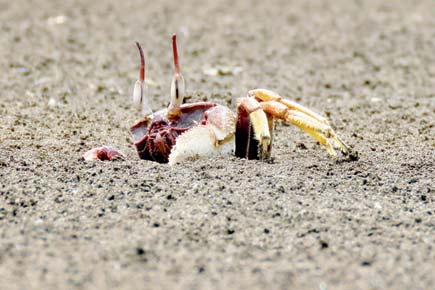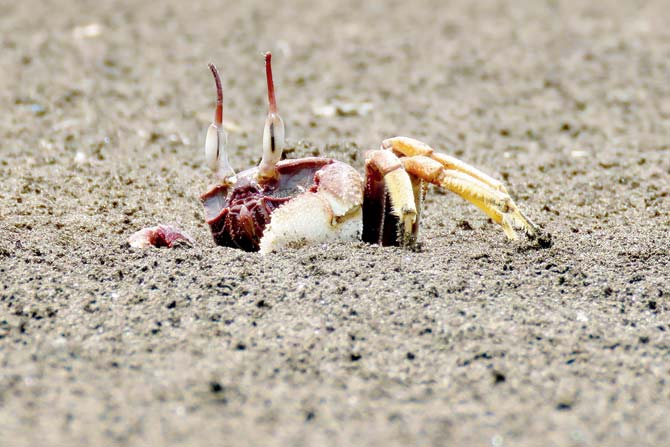In the last week of December, I took my interns for a walk to the coastline of Mumbai. We started at the Girgaum Chowpatty and headed towards the Sewri Fort and Bay area. The two spots together consumed the better part of our day.

To escape gulls or dogs, ghost crabs dive deep into their burrows
 In the last week of December, I took my interns for a walk to the coastline of Mumbai. We started at the Girgaum Chowpatty and headed towards the Sewri Fort and Bay area. The two spots together consumed the better part of our day.
In the last week of December, I took my interns for a walk to the coastline of Mumbai. We started at the Girgaum Chowpatty and headed towards the Sewri Fort and Bay area. The two spots together consumed the better part of our day.
ADVERTISEMENT
At Chowpatty, my friend Pradip Patade, who teaches kayaking, wind surfing and several other water sports, spoke to the group about his work on documenting the marine diversity of Mumbai’s coastline. The wide diversity he has photographed and located in the last few years, right here in our seemingly polluted waters, is fascinating . We were like kids in a candy store, watching goggle-eyed, listening to every story he had to share. By noon, the tide was high, but we couldn’t resist the temptation of taking a walk on the beach and exploring the mysteries it had in store for us. There were hundreds of gulls bobbing up and down and swaying in the tide, creating a ruckus over some morsel thrown from a nearby pier or picking up floating debris. While we stood identifying them through our binoculars, something darted from near our feet. The startled interns watched the ghostly figures dart across and disappear into the sand.

To escape gulls or dogs, ghost crabs dive deep into their burrows
It took some of us more than a few minutes to actually locate them. There were literally hundreds of ghost crabs, darting, freezing and disappearing into deep burrows, right there on the wide expanse of the silvery sands.
Generally known to be nocturnal feeders, ghost crabs are semi-terrestrial box crabs from the Subfamily Ocypodinae, found along all tropical and sub-tropical beaches of the world. They have many interesting features which have made them subjects of study among ecologists and marine biologists who specialise in the fauna of the inter-tidal zone. Their ability to camouflage and modify their general body coloration to the local sand grain colour by a readjustment of the colour pigments in chromatophores, has made them critical study subjects even for defence personnel.
Fast runners, they use a combination of stealth and speed to outrun their predators. However, their best bet in escaping gulls, other bigger crabs or dogs, is to dive deep into their burrows. Generally they dig single entry burrows, which end in a wider chamber, though sometimes distant connecting tunnels also exist.
Like all other crabs, they have five pairs of legs and use their first modified claw-bearing pair or chillae to scavenge on a huge variety of material. On closer inspection, one realises that bearing unequal sized claws is not a trait specific to the fiddler crab males. In fact, both male and female ghost crabs display this trait. Ghost crabs use the large claws and the specialised stridulating (sound producing) ridge present on them to communicate with each other.
The breathing gills and elongated eyes are another peculiarity of this group. Ghost crabs absorb moisture by running into the sea surf and wetting their gills. But, they cannot swim and will drown if they don’t make it to the land within minutes. The eyes of all ghost crabs are elongated and swollen stalks with large corneas on the entire bottom half. This gives them acute vision and the ability to use them like periscopes.
Ghost crabs are crucial to the cycling of food on our beaches as they hide food deep inside the sand. Sadly, excessive compaction of beaches due to driving of cars, sand-biking, horse-chariots, illegal sand-mining or oil pollution from motor boats is threatening these phantoms of our Mumbai coast. Next time you are on the beach be sure to sit still and let these decapods amaze you with their antics.
Write in to Anand Pendharkar at sproutsenvttrust@gmail.com
 Subscribe today by clicking the link and stay updated with the latest news!" Click here!
Subscribe today by clicking the link and stay updated with the latest news!" Click here!






